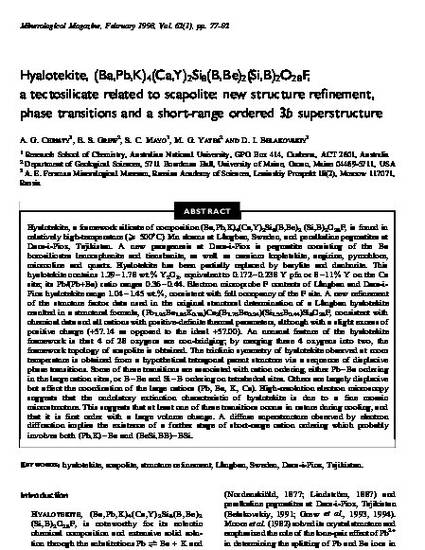
Hyalotekite, a framework silicate of composition (Ba,Pb,K)(4)(Ca,Y)(2)Si-8(B,Be)(2) (Si,B)(2)O28F, is found in relatively high-temperature(greater than or equal to 500 degrees C) Mn skarns at Langban, Sweden, and peralkaline pegmatites at Dara-i-Pioz, Tajikistan. A new paragenesis at Dara-i-Pioz is pegmatite consisting of the Ba borosilicates leucosphenite and tienshanite, as well as caesium kupletskite, aegirine, pyrochlore, microcline and quartz. Hyalotekite has been partially replaced by barylite and danburite. This hyalotekite contains 1.29-1.78 wt.% Y2O3, equivalent to 0.172-0.238 Y pfu or 8-11% Y on the Ca site; its Pb/(Pb+Ba) ratio ranges 0.36-0.44. Electron microprobe F contents of Langban and Dara-i-Pioz hyalotekite range 1.04-1.45 wt.%, consistent with full occupancy of the F site. A new refinement of the structure factor data used in the original structural determination of a Langban hyalotekite resulted in a structural formula, (Pb1.96Ba1.86K0.18)Ca-2(B1.76Be0.24)(Si1.56B0.44)Si8O28F, consistent with chemical data and all cations with positive-definite thermal parameters, although with a slight excess of positive charge (+57.14 as opposed to the ideal +57.00). An unusual feature of the hyalotekite framework is that 4 of 28 oxygens are non-bridging; by merging these 4 oxygens into two, the framework topology of scapolite is obtained. The triclinic symmetry of hyalotekite observed at room temperature is obtained from a hypothetical tetragonal parent structure via a sequence of displacive phase transitions. Some of these transitions are associated with cation ordering, either Pb-Ba ordering in the large cation sites, or B-Be and Si-B ordering on tetrahedral sites. Others are largely displacive but affect the coordination of the large cations (Pb, Ba, K, Ca). High-resolution electron microscopy suggests that the undulatory extinction characteristic of hyalotekite is due to a fine mosaic microstructure. This suggests that at least one of these transitions occurs in nature during cooling, and that it is first order with a large volume change. A diffuse superstructure observed by electron diffraction implies the existence of a further stage of short-range cation ordering which probably involves both (Pb,K)-Ba and (BeSi,BB)-BSi.
Available at: http://works.bepress.com/edward_grew/11/
